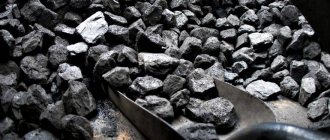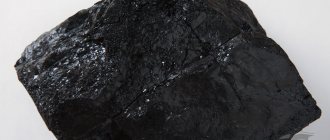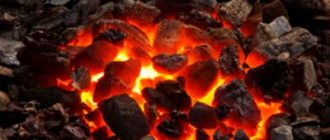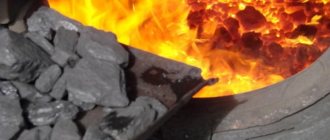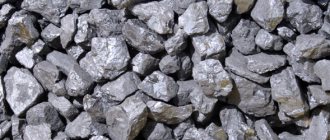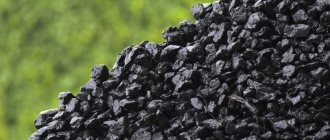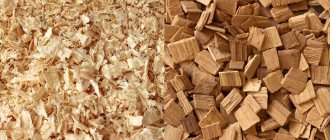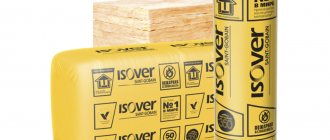There is no generally accepted division of coal into types. Different countries use their own systems.
In Russia, coal is divided into 3 types in accordance with GOST 32464-2013:
- Brown
- Stone
- Anthracite
All three belong to the so-called fossil coals. They were formed from plant remains. Millions of years ago, decomposed plants in swamps turned into peat. From peat, brown coal was formed, then hard coal and finally anthracite.
The process of turning peat into coal is called metamorphism, or carbonification. You can read more about this in our article How coal was formed.
In addition, there is also charcoal, coke and semi-coke. We will not talk about them in this article, because these varieties are obtained artificially after processing wood or coal. Fossil coal is a sedimentary rock.
Next, we will describe all three types of fossil coals, talk about their features, differences and purposes. There is also a more complex division of this material into brands, classes, types, and so on. You can familiarize yourself with different classifications of material on the pages Coal grades and Classes, categories, types and subtypes of coal.
Coal mining
The coal mining process is quite complex in terms of technology and requires large expenses to attract equipment and resources. Modern industry has three main methods for extracting this mineral:
- Career, through the organization of the cut.
- Mine method. Through the construction of a number of underground structures.
- Hydraulic. Using liquid jets, both as formation destroyers and as a transporting material.
Mine method
One of the oldest and most advanced methods of mining today. When coal is buried deep (more than 500 meters underground), stripping operations will require enormous costs. Therefore, the most cost-effective option is to construct a shaft followed by laying horizontal passages.
After organizing the technological process: strengthening walls and laying rails, ensuring ventilation and removing water, putting into operation tunneling cutters and shearers, coal mining and transportation to the surface begins.
The mining method is quite expensive and unsafe, although it provides large volumes of high-quality raw materials without causing significant environmental damage to the environment.
Career way
A method used in cases of shallow rock occurrence (up to 500 meters in depth).
Using tracked or rail draglines (cranes with a boom and a bucket), the soil is initially opened and then transported to nearby dumps. After which the coal is extracted and sent for processing and enrichment. When the deposit is fully developed, the reverse process of returning the waste rock to the site of removal occurs. The territory is being landscaped and landscaped so that it subsequently blends harmoniously into the surrounding landscape.
The disadvantage of the method is the low quality of the mined coals and the significant environmental damage caused to nature.
Coal mining
Volume of emissions of harm to the environment
In addition to the impact on human health, the use of coal poses serious consequences for the environment and for ecology in general. Disappearance of streams, alteration of natural drainages, water pollution, additional erosion, and acidic runoff into surface waters are just some of the potential impacts.
The Surface Mining Control and Reclamation Act is being enacted around the world, requiring strips of mined land to be returned to their original biotic productivity.
Like all fossil fuels, coal emits carbon dioxide when it is burned. In fact, fossils are responsible for most of the carbon dioxide emissions. Additionally, most of this mineral also contains certain amounts of other elements such as sulfur, mercury, and sometimes lithium. Combustion results in the formation of NOx and SOx.
Coal processing and enrichment
Since fossil coals contain a number of mineral impurities, and the requirements for the quality of energy fuels increase sharply, there is a need for additional purification of the extracted minerals. This process is called enrichment.
Refining is a range of technologies designed to convert washed coal into high-quality fuel. It is based on the following methods:
- Pyrolysis or coking, that is, high-temperature heating without air access.
- Semi-coking – low-temperature coking.
- Destructive hydrogenation is the process of producing “synthetic oil” under the influence of hydrogen at a temperature of 400-5000C.
- Gasification – conversion of solid coal into gas through high-temperature heating with the presence of air separation products: hydrogen, oxygen, carbon dioxide and water vapor.
- Plasma-chemical processing is a promising method that makes it possible to obtain liquid fuel and a number of particularly valuable chemical compounds in the form of silicon-containing substances and ferrosilicon.
Preparation
The primary stage of beneficiation, carried out at mining and processing plants, the purpose of which is to identify components containing coal and bring them to the desired size level.
This happens using:
- Screens are devices containing boxes with sieves or gratings with holes of predetermined sizes.
- Classifiers are units for separating coal into fractions in a liquid medium, through the floating of small light particles and the settling of larger and heavier ones.
- Crushers – grinding installations.
As a result, types of coal that are standard in size level are obtained:
- dimensions more than 100 mm - slab;
- 50-100 mm – large;
- 26-50 mm – walnut;
- 13-25 mm – small;
- 6-13 mm – seed;
- less than 6 mm - piece.
Coal of non-standard sizes is called raw coal.
"Simple" enrichment
The method involves manually selecting pieces of the desired type or size, as well as sifting by sliding and falling down an inclined plane.
Flotation
A method based on the floating in a liquid medium of foam formed by particles coated with fatty hydrocarbon processing products (reagents) with air bubbles adhering to them. The resulting mineralized foam layer is removed, cleaned, dried and used as coal concentrate.
Gravity enrichment
This type of enrichment uses the difference in the physical properties of particles having different densities and geometric sizes. It is clear that pieces of rock that are so unequal in weight and dimensions will acquire different speeds of movement in liquid or air. As a result, the primary product is divided into concentrate and waste - mixes. The waste can be sent for re-enrichment or used as low-calorie fuel.
Other types of classifications
In addition to the brands presented above, there are many intermediate brands, for example, fatty coke (KZh), gas sintering (GS), long-flame gas (LDG).
Also, each grade of coal may have different pieces sizes. In this case, the letter indicating the variety is located after the letter indicating the brand. For example, anthracite-nut (AO), fat-slab (ZhP), coke seed (KS).
There is also a classification of coal by origin. All coal, as already mentioned, is formed from plants over millions of years. But plants can have different natures. Thus, coals are divided into humus (from wood, leaves, stems) and sapropelite (from the remains of lower plants, such as algae).
Application
In energy
Three quarters of global coal production is spent on energy purposes. Half of this use of this type of fuel is burned in the furnaces of boilers at thermal power plants, a significant part provides housing and communal needs, and to a lesser extent coal is burned by boiler houses of individual regions and industrial enterprises.
Until recently, the most common fuel on Earth played a leading role in the global economy. Today, the position of coal has been somewhat replaced by natural gas and oil. Although even now 40% of electricity is generated by burning coal, and in India and China this figure reaches 75%, in southern African countries - up to 94%.
Application of coal
The main disadvantages of using this type of fuel are:
- Huge waste of resources. To generate 1000 MW of electricity, 9000 tons of coal are required. In fact, it is a giant train of 90 cars, each with a capacity of 100 tons!
- Air pollution with sulfur and nitrogen oxide. When burning coal, methane and carbon dioxide are also released. Considering the fact that low-grade grades of this mineral are largely used as energy fuel, the problem is aggravated.
- The need to remove and utilize ash, which encounters serious technological and financial problems.
- The use of large volumes of water, which subsequently must be thoroughly purified. But even in this case, significant harm is caused to the environment.
In construction
The construction industry uses this natural resource in several ways.
First of all, coal is used in the production of building materials: cement, limestone, alumina. In addition, waste from the processing and combustion of this mineral is actively used as fillers when performing excavation work, as well as for the manufacture of roofing, cladding, and wall materials. This material is also used as a hygroscopic agent to neutralize harmful odors and normalize the level of humidity in rooms.
In medicine
The medical aspect of the use of activated carbon is based on its properties - to bind and remove poisons and harmful substances from the body, which is extremely necessary for a number of diseases and poisonings.
In addition to this, one can note its filtering properties when purifying water and air.
Anthracite (A)
This is the highest quality coal in terms of calorific value. Its carbon content can reach 98%. Only graphite has more. And in appearance, anthracite is very different from other brands. It has a dark black color with a pronounced metallic tint. It also has increased heat resistance and electrical conductivity. The combustion temperature of anthracite is quite high, so it cannot be used as a fuel in all types of stoves. In addition, it is used in metallurgy, for the manufacture of filters, electrodes, calcium carbide, and microphone powder. This coal does not sinter, so it has no use in coking, although even without this process it can replace coke in some processes.
Deposit in Russia and the world
The world's ten largest coal deposits are as follows:
- The Tunguska basin with reserves of 2.299 trillion. tons ranks first on the list. Russia. Irkutsk region, Krasnoyarsk region, Republic of Sakha (Yakutia).
- The Lena basin has an area of 750 thousand km2 with reserves of 1.647 trillion. tons is in second place. Russia. Central Yakut lowland.
- The Kansk-Achinsk basin, with 638 billion tons and a length of 800 km along the Trans-Siberian Railway, ranks third on the list. Russia. Krasnoyarsk Territory, Irkutsk and Kemerovo regions.
- Kuzbass – 635 billion tons. Russia. Kemerovo region, Altai region, Novosibirsk region.
- Illinois Basin - 365 billion tons. The basin area is 122 thousand km2. USA. States of Illinois, Kentucky, Indiana. 9 layers, 2 of which provide 90% of the production: Harrisburg, Herrin.
- Ruhr basin - 287 billion tons, 6.2 thousand km2. Germany. One of the oldest coal areas in the world, where mining began in the 13th century.
- Appalachian basin – 284 billion tons, 180 thousand km2. USA. States: Alabama, West Virginia, Kentucky, Maryland, Ohio, Pennsylvania.
- Pechora basin – 265 billion tons, 90 km2. Russia. Nenets Autonomous Okrug and the Komi Republic.
- Taimyr basin – 217 billion tons, 80 thousand km2. Russia. Taimyr Peninsula.
- Donbass – 141 billion tons, 60 thousand km2. Ukraine, Russia, DPR and LPR.
In total, there are 50 active coal deposits in the world.
Popular message topics
- The surface of our region,
Russia, is located on a continent called Eurasia. The world map shows that it is located in eastern Europe and northern Asia and its outline resembles a running horse. The country is very large - it owns 1/9 of the entire landmass, - Cotton
We often come across the words cotton and cotton products in everyday life. Few people know that cotton itself is not a plant, it is only a fiber that a person receives when growing cotton. Today cotton is the most - Pyramids of Ancient Egypt
There are no people who have not heard anything about the pyramids of Ancient Egypt. These are majestic, monumental structures created several thousand years ago. For so many years, disputes about these structures have not subsided, new myths and theories regarding
Coal producing countries
The leaders in terms of coal production volumes, according to the Statistical Review of World Energy, in 2022 were:
- China – 3,846 million tons.
- India – 756.4 million tons.
- USA – 639.8 million tons.
- Indonesia – 610.0 million tons.
- Australia - 506.7 million tons.
- Russia – 440 million tons.
- South Africa – 254.3 million tons.
- Germany – 133.9 million tons.
- Kazakhstan – 115.4 million tons.
- Poland – 112.4 million tons.
Author: Yuri Florinskikh All articles by this author
Latest articles by the author: The largest producers of milk and dairy products in the world Diamonds: properties, mining methods and applications
Resources
Total world coal resources, i.e. the amount of coal that was in the depths before it began to be mined is estimated at a total value of more than 15,000 billion tons; Of these, approximately half are available for mining. The bulk of the world's coal resources are in Asia and are concentrated primarily in Russia and China, which are the largest coal producers. North America and Western Europe occupy second and third places, respectively, in terms of coal resources and are also very large producers.

